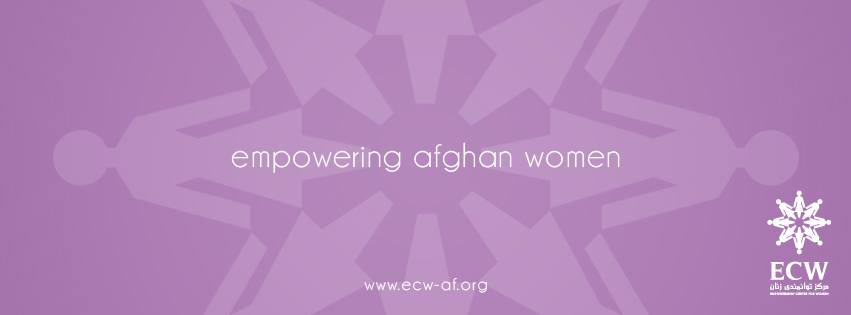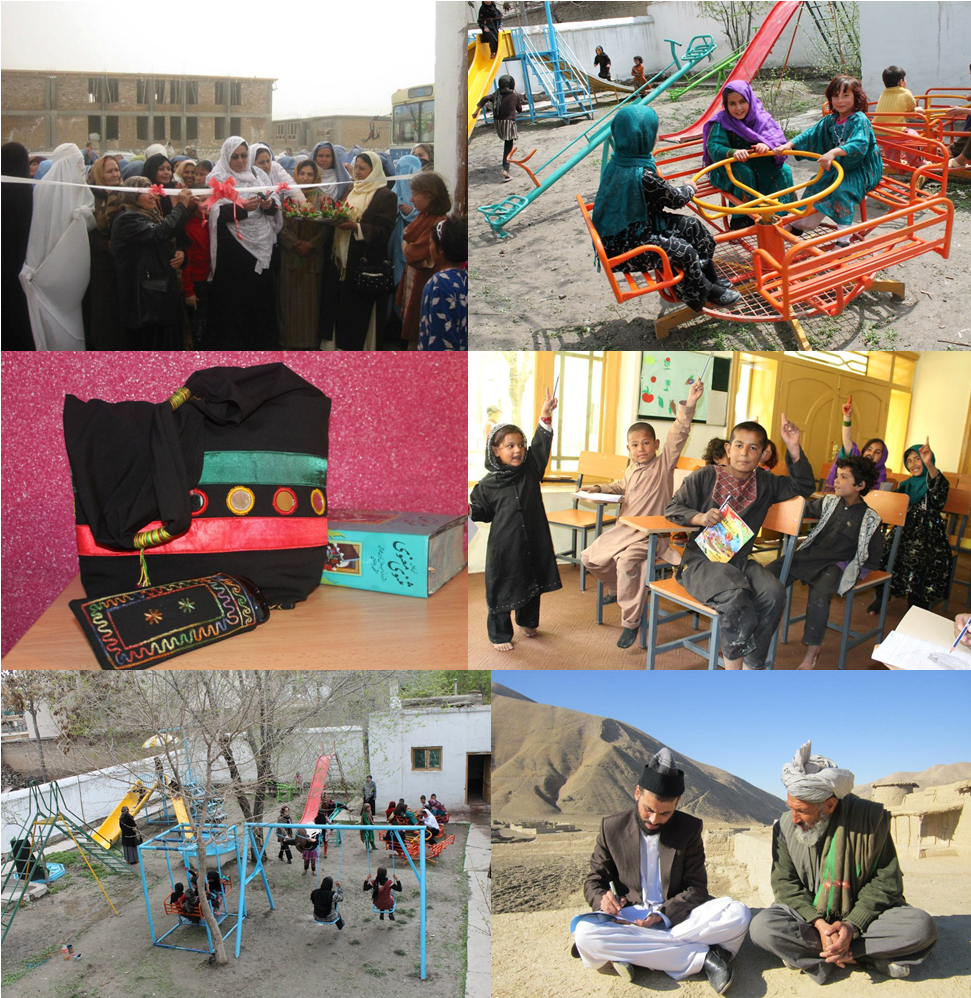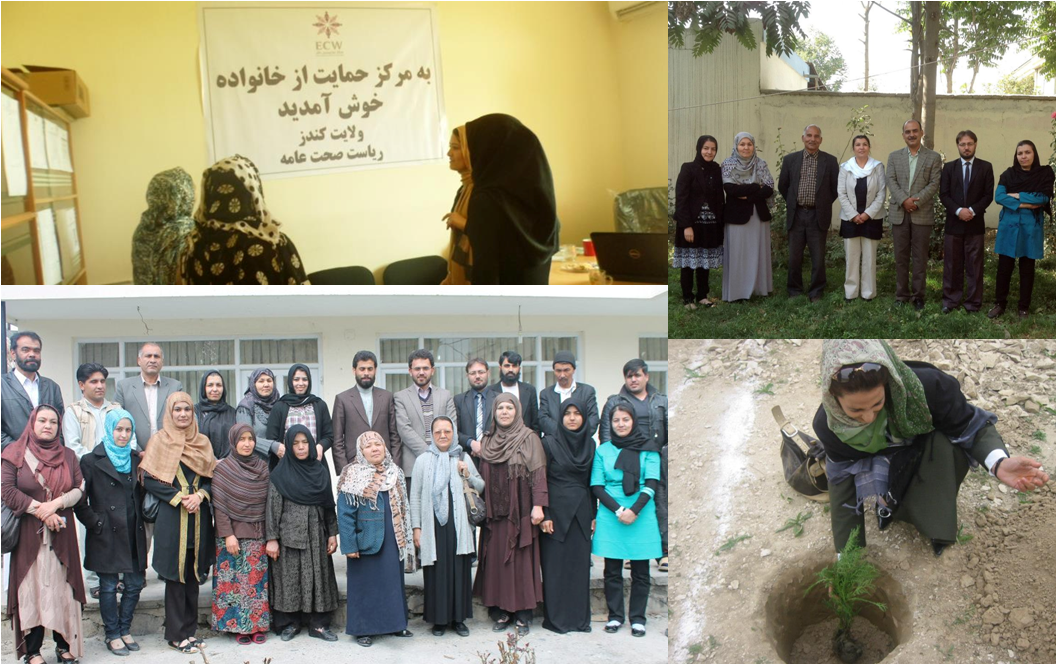The Empowerment Center for Women (ECW) is a grassroots organisation in Afghanistan, established with the aim of supporting and providing resources to Afghan women and girls to help them to become empowered, economically independent and socially active.
Since its establishment the organisation has continuously expanded its services to different parts of the country, and they now work in the Central Zone (Kabul, Panjsher, Parwan, Kapisa, Ghazni, Bamyan), Northeast Zone (Kunduz, Takhar, Baghlan, Badakhshan), North Zone (Balkh, Faryab, Jawzjan, Samangan) and East Zone (Nangarhar, Laghman, Kunar).
The ECW vision is for Afghan women to have the skills and support to allow them to fully engage in their society, to have the right and opportunity to participate in, negotiate with, and hold accountable institutions that affect their lives.
ECW’s key achievements to date have been in Civic Education, using a diverse balance of suitable approaches to encourage citizens, especially women, to vote. These approaches include building social dialog, debate, face to face session, conferences, advocacy meetings with governmental organizations, providing long term and short term training, providing resources for women to utilize their skills for their economical growth, along with supporting internships and education courses.
Over the years they have been working with partners to build internal capacity, raise awareness, and through targeting religious leaders and communities have advocated for women’s rights, the peace process, increased access to justice, and ending violence against women.
ECW holds as core values: gender sensitivity; transparency &and accountability; respect at work; professionalism and non-discrimination. The 2013-2015 strategic goals for the organization are gender development, access to justice, investment in people, peace building, good governance, and organizational development.
To find out more you can visit their website and find them on Facebook too.
Afghan women are playing an active role in Afghan society in at least the majority of big cities in the country. This includes their role as teachers, doctors, nurses, police officers, government ministry personnel, civil society and NGO representatives and activitists. Women have also been active members of the Afghan political arena for the last 12 years. In both the Parliament (Lower House) and the Senate (Upper House), 27% of representatives are women.
There have been a number of changes that can be considered positive for women in Afghanistan.
From the legislation point of view, the Afghan Constitution has given equal rights to men and women in the country. There have also been a number of new laws and policies, including the Elimination of Violence against Women Law that has benefited and empowered women in various ways. Therefore as long as the constitution is not changed, this will continue to be a positive change one which will benefit women in the future also.
In terms of participation, the establishment of the Ministry of Women’s Affairs led by a woman minister, and the Ministry of Public Health, also led by a female Minister, are very positive signs of progress. Women constituting 27% of the Afghan Senate and Parliament is a sustainable change. The number of girls receiving an education has increased to millions today across the country. Women also have roles in other spheres of Afghan society and have roles as teachers, security forces officers, doctors, civil society and activists.
Women have a clear vision, understand the situation of Afghanistan, and have their own views to share now on a daily basis. This is a very positive development since women were considered “illiterate wearers of burkas†as recently as 2001.
Women are also very active as entrepreneurs. Women own businesses, factories and produce artwork. This has helped women’s empowerment.
At the moment, Afghanistan is in the transition process from control by international forces to control of the Afghan National Security Forces. At the end of 2014 the whole security responsibility will be given to Afghanistan.
The big question is how things might change with this transition. There are still a number of challenges not fully addressed for supporting a better life for the women in Afghanistan. With less political will of the government, many remaining challenges could still remain unattended following withdrawal of foreign forces.
Where girl’s education has been an opportunity, the growing insecurity, and a lack of schools for all girls in the country, and the conservative attitudes of people towards girl’s education and social life have remained a huge challenge. Girls still suffer from acid attacks and poisoning. This has drastically increased in the years 2011 and 2012 throughout the county.
Whereas women’s political participation is an extremely positive step, women still do not enjoy a secure and harassment free environment to contribute the way they want to. The entire government system is full of warlords who could challenge the life of a woman at any time. There is also a serious social backlash against outspoken women usually women who are courageous enough to raise their voice are given names such as US/ UK terms for women with low moral behaviour and sometimes even their families and background are questioned.
There are plans, laws and institutions that focus on gender equality but the implementation and capacity has always remained a challenge. The Ministry of Women’s Affairs always faces a serious challenge in monitoring the implementation of National Action Plan For The Women of Afghanistan (NAPWA) due to common understanding of women’s issue as a secondary topic. The lack of political will has not helped in the implementation of this plan.
There is a serious lack of will from the concerned government officials on rule of law and access to justice when it comes to women. Women are still facing severe cases of violence against them, stoning, self-immolation, rape, slavery, and even murder. The huge problem here remains a lack of a system for implementing and monitoring the Elimination of Violence against Women (EVAW) law.
Women’s movement is risky and challenging across the country with almost no violence prevention and protection mechanism. If a women activist is at risk in Afghanistan, she has nowhere to go and hide. Getting out of Afghanistan and obtaining a visa is not easy for any Afghan, particularly women.
Changing the society and mentality at the community level is very important, risky but possible. There is a need to assess the situation of the country and the way women live across 34 provinces. Afghanistan is a diverse country with different cultural, traditional practices and means of living.
Taking this diversity into consideration, there is a need to plan programs that target the communities and their mentalities towards women. The target groups can be identified into two. First, women who in general know about their rights and what is best for them to live a normal life. Second, the other group has to be men who dominate discussions, decisions and have a rigid attitude about women’s roles.
This is possible through educating and raising awareness, taking into consideration the appropriate methods for each context. For example, in Kandahar province, it is very difficult to start talking about international laws and women’s rights where the society is more religious and traditional. This is where religion can be used as a very strong and positive tool to address women’s rights and the importance of equality, etc.
Measures which need to be supported to allow Afghan women to develop their futures can be seen as the following;
- The security transition can only be successful if women are part of it. Women’s collaboration, social life and daily participation should be an indicator of the success of this process. Women’s confidence should be built until they are allowed to be equally active as men.
- Law implementation with focus on assisting women victims must be a priority for the government and the Ministry of Justice. The Supreme Court has to engage a woman judge within its council to ensure equality as well as to see women’s needs are addressed.
- There is still a huge need for raising awareness at two levels, taking into consideration NAPWA. a) Government officials on the issues of gender equality, non-discrimination, violence against women, responsiveness to the needs of women at various levels, etc. b) Working with the dominant local leaders such as councils, religious leaders and community representatives on women’s rights from the Islam, human rights, constitutional and other points-of-view.
- More efforts to focus on capacity development that are long-term and sustainable for women across Afghanistan. Women in Kabul have benefited enough but they do not represent women in the other 33 provinces in Afghanistan. The capacity development programs should include scholarships, internships, on-job trainings, skills building, etc.
- No peace negotiation should sacrifice women’s rights and freedom. There is a need for the international community’s support and pressure to ensure that 11 years of achievements are not lost.
- Finally, support to establish a mechanism for Women Human Rights Defenders in order to insure there is a system to use if their life is at risk.
Â
“What are your aspirations for Afghan women?”
ECW envisions an Afghanistan where women are empowered. This can be done through supporting Afghan women to participate in, negotiate with, influence, control and hold accountable institutions that affect their lives.



0 Comments